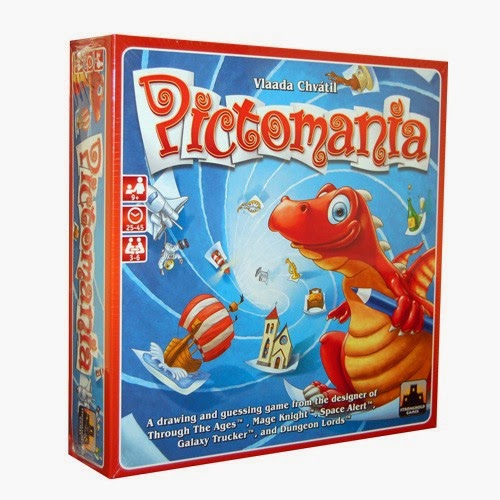Board game designer Vlaada Chvátil is mainly known for games as goofy as they are elaborate -- Galaxy Trucker, Space Alert, and Dungeon Lords all strike a light-hearted tone, perhaps at odds with the rather substantial rules you have to understand to play them. But he has on occasion gone in a simpler direction, such as with Sneaks and Snitches. He tried another different direction -- into party game territory -- with 2011's Pictomania.
At its core, Pictomania is a drawing-guessing game, in the family of Pictionary, Telestrations, and others. But the tweaks to the formula make Pictomania a dramatically different experience. Each round begins by placing six different clue cards in racks that all the players can see. Each card has 7 different things to draw on it. Players draw from separate decks, secretly and at random, to determine which clue on which card will be drawn. Then each of the players draws his own clue, simultaneously. And each player, using a personal hand of cards numbered 1 through 7, makes guesses as to what his opponents are drawing -- simultaneously with his own efforts to draw.
If you're thinking this sounds chaotic, you won't be surprised to hear the scoring can be equally so. Each player has chits in his color, worth decreasing numbers of points. The first opponent to guess your drawing gets your highest valued chit to add to his score. Later correct guesses are worth progressively fewer points. But you want to be sure to draw your own clue as best you can, as you'll lose points for every incorrect or missing guess on your own drawing.
But wait, there's still one more wrinkle. Each of the 7 things on any given clue card will be related somehow -- for example, all parts of the body, or all basic tools. This helps you make your guesses, but it can also be tricky for differentiating your own drawings when dealing with similar things.
There's a certain amount of cleverness and fun in this whole construct. But there also seems to be one key weakness. Strategy and time management are critical to doing well in the game -- you don't want to have your nose buried in your own drawing as opponents are already making guesses on each others' developing sketches. But put simply, "strategy" is a rather foreign concept for a drawing game. It's alien for most party games as well. And frankly, it's not an especially welcome addition. What happens when the so-called drawing game devolves into a game of chicken where no one wants to be the first to start, you know, drawing?
Worse, at the same time as this game is aspiring to loftier goals, it seems even more dependent on luck than the average party game. If one player gets to draw "needle" while his opponent is stuck with "conference table," who do you think is going to have more time to scrutinize the other players' drawings? And because this can happen, are you supposed to wait a second or two, to see if anybody is drawing something simple? What if everyone does that? We're back to an awkward state where no one wants to draw in the drawing game.
I'm hard-pressed to identify the target audience for the game. It seems too convoluted for party game fare, and too chaotic and fickle for something you're supposed to strategize about. It wasn't terrible, but at the same time, not everyone in my group actually had fun playing it. So all told, I'll have to give the game a middling C+.

No comments:
Post a Comment